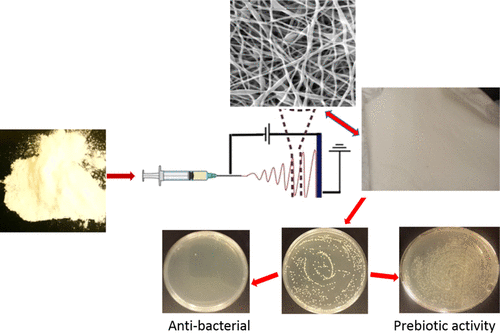Our official English website, www.x-mol.net, welcomes your feedback! (Note: you will need to create a separate account there.)
Novel Inulin Electrospun Composite Nanofibers: Prebiotic and Antibacterial Activities.
ACS Omega ( IF 4.1 ) Pub Date : 2020-02-05 , DOI: 10.1021/acsomega.9b03957 Walaa Wahbi 1 , Rania Siam 2 , James Kegere 1 , Worood A El-Mehalmey 1 , Wael Mamdouh 1
ACS Omega ( IF 4.1 ) Pub Date : 2020-02-05 , DOI: 10.1021/acsomega.9b03957 Walaa Wahbi 1 , Rania Siam 2 , James Kegere 1 , Worood A El-Mehalmey 1 , Wael Mamdouh 1
Affiliation

|
Inspired by the rampant digestive disorders and the vast bacterial infections, this study aimed at fabricating nanofibers made of inulin/polyvinyl alcohol (PVA) composite nanofibers (CNFs) using the electrospinning technique and testing their prebiotic and antibacterial activities. The inulin/PVA CNFs were tested for prebiotic activity with Lactobacillus species while Escherichia coli (E. coli) and Staphylococcus aureus (S. aureus) were used to assess the antibacterial potentiality. During the fabrication of the CNFs, different electrospinning parameters have been carefully controlled, in order to produce nanofibers with relatively uniform diameter, fewer beads, and high integrity. The different parameters included variable solution concentration (material ratio varied from 14 to 20 wt %), applied voltage (varied from 15 to 25 kV), and solution flow (ranged between 0.005 and 0.5 mL/min). The chemical characteristics, thermal stability, and morphology of the formed CNFs were comprehensively characterized by Fourier transform infrared spectroscopy, thermogravimetric analysis, and scanning electron microscopy. Selected CNFs, showing the best diameter uniformity and integrity, were tested for the prebiotic and antimicrobial activity. A 38% increase in prebiotic activity of CNFs, compared to their bulk solution, was observed. The antibacterial activity of the selected CNFs was enhanced, from ∼40% (pure inulin) to 70% (inulin/PVA CNFs) against E. coli and 45% against S. aureus. This study investigates the prebiotic and antibacterial activities of PVA/inulin CNFs and provides the foundation for inulin/PVA CNF use in the healthcare sector, as in disinfectants and/or digestive disorders.
中文翻译:

新型菊粉电纺复合纳米纤维:益生元和抗菌活性。
受普遍的消化系统疾病和广泛细菌感染的启发,本研究旨在使用静电纺丝技术制造由菊粉/聚乙烯醇(PVA)复合纳米纤维(CNF)制成的纳米纤维,并测试其益生元和抗菌活性。测试了菊粉/ PVA CNF与乳酸杆菌的益生元活性,同时使用大肠杆菌(E. coli)和金黄色葡萄球菌(S. aureus)评估抗菌潜力。在CNF的制造过程中,已经仔细地控制了不同的电纺丝参数,以便生产具有相对均匀的直径,更少的珠子和高完整性的纳米纤维。不同的参数包括可变的溶液浓度(材料比例从14到20 wt%不等),施加的电压(从15到25 kV不等),和溶液流量(范围介于0.005和0.5 mL / min之间)。通过傅里叶变换红外光谱,热重分析和扫描电子显微镜对形成的CNF的化学特性,热稳定性和形态进行了全面表征。测试了显示出最佳直径均匀性和完整性的选定CNF的益生元和抗菌活性。与它们的整体溶液相比,CNF的益生元活性提高了38%。选定的CNF的抗菌活性从对大肠杆菌的约40%(纯菊粉)提高到70%(菊粉/ PVA CNF),对金黄色葡萄球菌的抗菌活性达45%。这项研究调查了PVA /菊粉CNF的益生元和抗菌活性,并为医疗保健领域使用菊粉/ PVA CNF提供了基础,
更新日期:2020-02-18
中文翻译:

新型菊粉电纺复合纳米纤维:益生元和抗菌活性。
受普遍的消化系统疾病和广泛细菌感染的启发,本研究旨在使用静电纺丝技术制造由菊粉/聚乙烯醇(PVA)复合纳米纤维(CNF)制成的纳米纤维,并测试其益生元和抗菌活性。测试了菊粉/ PVA CNF与乳酸杆菌的益生元活性,同时使用大肠杆菌(E. coli)和金黄色葡萄球菌(S. aureus)评估抗菌潜力。在CNF的制造过程中,已经仔细地控制了不同的电纺丝参数,以便生产具有相对均匀的直径,更少的珠子和高完整性的纳米纤维。不同的参数包括可变的溶液浓度(材料比例从14到20 wt%不等),施加的电压(从15到25 kV不等),和溶液流量(范围介于0.005和0.5 mL / min之间)。通过傅里叶变换红外光谱,热重分析和扫描电子显微镜对形成的CNF的化学特性,热稳定性和形态进行了全面表征。测试了显示出最佳直径均匀性和完整性的选定CNF的益生元和抗菌活性。与它们的整体溶液相比,CNF的益生元活性提高了38%。选定的CNF的抗菌活性从对大肠杆菌的约40%(纯菊粉)提高到70%(菊粉/ PVA CNF),对金黄色葡萄球菌的抗菌活性达45%。这项研究调查了PVA /菊粉CNF的益生元和抗菌活性,并为医疗保健领域使用菊粉/ PVA CNF提供了基础,


























 京公网安备 11010802027423号
京公网安备 11010802027423号